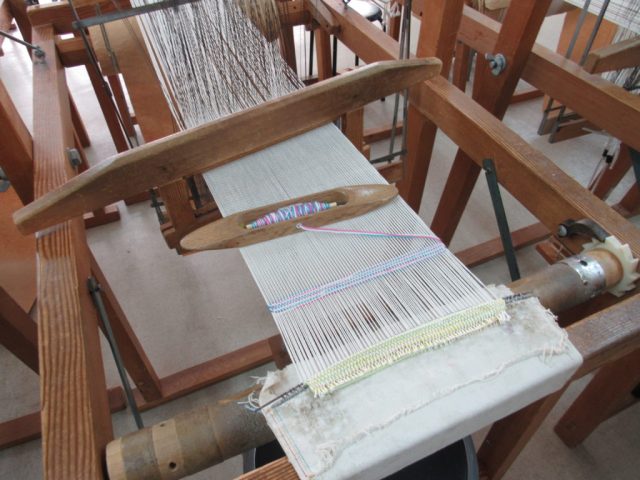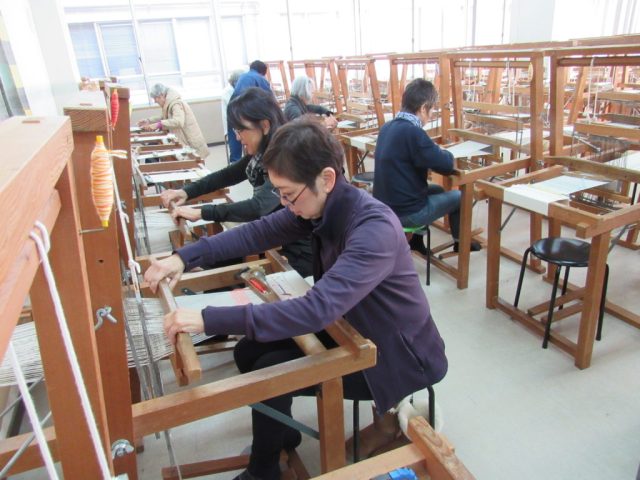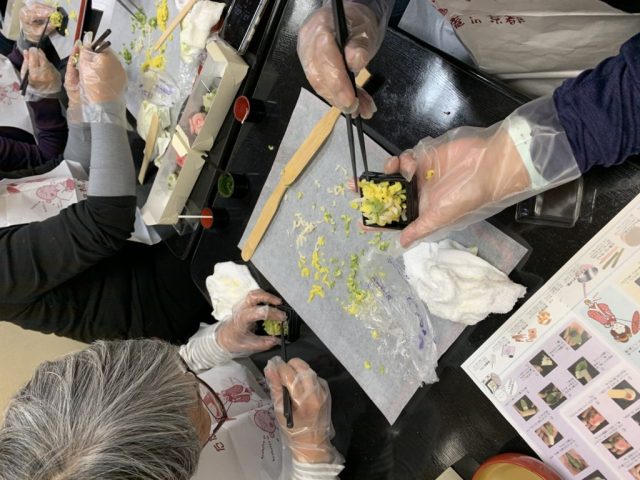Day 1 & 2 Honolulu – Kansai – Kyoto
We traveled to Kansai Airport via Delta Airlines. We met at the main terminal at the Delta Airline’s check in counter. We got together about 3 hours prior to our flight to make sure all of us get through the TSA checkpoint. We checked in and had some time at the airport so everyone enjoyed shopping for a while. Our flight time was a little less than 10 hours. We all enjoyed watching movies on the plane. We landed in Kansai on time and met our local guide. There were others on this tour that flew with Japan Airlines and arrived earlier than us. We met up with them and arrived at Keihan Kyoto Hachijoguchi hotel around 7:30pm. We checked in to nice rooms and several of us went for a walk to Kyoto station for dinner. Others went to the convenience store which was nearby. All of us enjoyed Japanese dinner and bento.
Day 3 Kyoto
Our hotel just opened December 2019 so the rooms were new. We enjoyed a great breakfast. It was a very nice day to start our Kyoto tour. We met our English speaking guide at hotel lobby and started our Kyoto excursion. Our first stop was at Marumasu-Nishimuaya to experience Kyo Yuzen fabric dyeing. Yuzen dyeing is one of the traditional art styles around Japan and has been around since the 17th century. Hand painting the designs directly onto Kimono (freehand painting) became established in Kyoto. At the end of 19th Century, a vast range of colorful chemical dyes came into use. Then the method of stencil dyeing was developed. Japanese people have a strong affinity for the beauty of nature and the theme for kimonos are based on what they see in nature, like flowers, birds and landscapes. We were provided a good size tote bag, stencil pattern and paints. We learned how to color the stencil onto the tote bag. It wasn’t difficult at all!! Painting onto stencil was so much fun. We all enjoyed coloring! We finished one side of the tote bag and some of us had enough time to paint other side of the tote bag. We learned a lot about Yuzen style of dyeing.








After making our Yuzen tote bag, we went to Kawaramachi for Sou Sou Shopping!
Sou Sou was established in 2002 and is based in Kyoto. Sou Sou created textile which is designed to depict the seasonal beauty of nature and founded on the concept of “Creating New Japanese Culture”. While pop and edgy, the brand is using skilled craftspeople and time-tested materials to decorate modern life. Sou Sou makes and sells tabi shoes, kimono, wagashi, furniture and etc. to develop collaboration in a broad range of fields to broaden the possibility of Japanese textile design.
There are many branches in one area and we all enjoyed shopping at Sou Sou.
We enjoyed having lunch at Kawaramachi area.






After we had lunch, we headed to the Kyoto Handicraft Center to making our own Kyo Damascene. (Kyo-zogan). Damascene is a design inlaid with pure gold and sterling silver. Kyo Damascene is one of a number of gorgeous and delicate traditional Japanese crafts. The earliest damascene was a bronze mirror founded in Luoyang, China. Through out the long history, the technique was introduced into Japan through China and the Korean Pennisula, and it was held in high esteem as a guard of a sword, armor, and ritual article. Nowadays, the historic technique is used for accessories and ornaments. We tried to make a circle damascene in either necklace or strap design. It was tedious work to place small pieces of gold and silver confetti to create a design. We chose designs that we liked and laid the pieces of confetti on the steel surface. We were only able to do the designing and the Handicraft center finished everything else for us. We had to wait about 4 weeks to get our completed designs which turned out beautifully. We then had enough time to shop around the center. There were many Japanese books, sweets, kimono, pottery and lacquer ware and many more items to purchase for ourselves and as souvenir. We then returned to the hotel and enjoyed another dinner in Kyoto.





Day 4 Kyoto
After a great breakfast, the first stop was the Toji Temple. It was this year’s first Flea Market and is only held once a month.
The Toji Temple is a World Heritage Site and is only 15 minutes away by bus from our hotel. This temple is very famous for its five-storied pagoda and old, beautiful Buddhist buildings. On the 21st of each month, there is a big and vibrant flea market. Many vendors were there – crafty items, old Japanese fabrics, kimono, bonsai, ceramics, and many food vendors. All of us enjoyed the many different vendors. We shopped from dried seafood to dried fruits, kimono fabrics, small handmade pouches and etc. Before boarding the bus, we enjoyed fresh backed anko mochi.








After the Toji Temple, we went to the Nishiki Market which is a narrow street that is five blocks long. It’s lined with more than one hundred shops and restaurants. Known as “Kyoto’s Kitchen”, this lively retail market specializes in all things related to food from fresh seafood and produce, knives and cookware. This is a great place to find seasonal foods and Kyoto specialties, such as Japanese sweets, pickles, dried seafood and sushi. We spent our entire lunch time perusing the shops.






After the Nishiki Market, we headed to the Nishijin Textile Center. We went there for a hand weaving workshop. We used a handloom and weaved a centerpiece weaving (approx. 20cm x 20cm). It was quite interesting to make one. It normally takes a good 40 minutes to finish but since we are all crafters, we finished within 30 minutes. We were so proud of ourselves to complete great piece.
The origin of Nishijin weaving can be traced back to more than 1,000 years ago. The name of Nishijin literally means the fort of west forces, from the fact the location was used that way about 550 years ago during Onin War. In 1872, three students were sent to Europe by the Kyoto government to adopt Jacquard loom which results in mass production of sophisticated, high quality textile. Since then Nishijin has been renowned as representative luxury fabrics of Japan.








After the workshop, we had a chance to see Kimono Show. We saw beautiful Nishijin Obi, Yuzen Kimono, Tsumugi and other fabrics kimono on stage. Then we had time to shop, too.




After the Nishijin Textile Center, we headed to make Nerikiri – for Japanese traditional sweets. Nerikiri is one of the Japanese traditional sweets (Wagashi). Nerikiri sweets are almost like art. It’s designed to show seasonal designs and colors and has deep a strong relationship with tea ceremony. It became very popular in Kyoto because of the popularity of the tea ceremony.
Nerikiri is 90% Anko, Japanese bean paste. The beautiful outside layers are made with Shiroan (white bean paste) mixed with sweet and soft Mochi (called Gyuhi), colored and finally shaped. Typically, Koshian (smooth red bean paste) is added inside for taste.
We were there to make 3 different kinds of Nerikiri – Tsuyukushi, Sakurakuzushi and Otoshifumi. Tsuyukushi is mixture of green, yellow and white leaves. We used a strainer and made small pieces of leaves with 3 different colors. We made an anko ball and put those small pieces on and finally completed Tsuyukushi. To make Sakurakuzushi, we to wrapped anko balls with light pink paste, and decorated with darker pink paste petals. It really looked like cherry blossoms. To make the Otoshibumi – we wrapped anko with green and white paste. Then shaped the leaf with tools with green paste with white streak. The 3 sweets were perfect for our desserts after dinners. The last day in Kyoto was very productive and we enjoyed a wonderful dinner again.







Day 5 Kyoto – Tokyo
We packed our big suitcases so we could send them to Tokyo. We checked out of Kyoto Hotel and headed to Kyoto Station to ride a bullet train (Shinkansen) to Tokyo. We shopped for omiyage and snacks at Kyoto station. The weather wasn’t too nice and we couldn’t see Mt. Fuji from the train. The ride was 2 hours and 30 minutes on the Shinkansen. We arrived to Tokyo station and met with our Tokyo English guide at platform. She took us to Tokyo Station Ichiban Gai – character street and Tokyo ramen street. Everyone went on their own and we spread out. All of us had good lunch and shopped again. Then we headed to the first Tokyo hands on workshop.
We went to Ozu Washi specialty shop and museum to experience making Washi paper. Handmaking Japanese paper, we learned about the history and process of traditional washi making first so we were able to get good idea for what we were trying. Our teacher was so funny and great. It was very difficult to do kamisuki on our own. The teacher helped us to make washi paper together. He was so patient. The professional washi makers are very skilled and so was our teacher. We made our own washi paper in most traditional way! Again it was difficult.
We saw the history museum and the shop, too.
Then we checked into our Tokyo hotel in Ikebukuro – the location is great for dining and shopping!






Day 6 Tokyo
We had another great breakfast buffet at the hotel. At 9:30am, we departed for a day of fabric shopping! First we arrived at Nippori town. In the 1950s, wholesalers and retailers gathered in Nippori and started a black market to handle any kind of clothes and fabric left behind by the American forces. Since then, this district has hosted throngs of visitors, both domestic and international. Nippori is lined with textile, fabric and accessory stores, as well as second-hand kimono and vintage clothing boutiques.
We went to several shops and found many great fabrics. Prices were about 15% to 20% cheaper than regular retail shops. We were all satisfied shopping for fabrics for our next projects!

We moved to Ueno for lunch and shopping. We also enjoyed Yuzawaya which is a store that carries many notions, fabrics and craft goods. Then we walked around Ameya Yoko-cho (Ameyoko) area for more shopping. Ameyoko is a vibrant shopping arcade filled with around 400 shops of different genres. It houses a wide array of dining and drinking spots where they will let you easily eat while walking the area. There are shops where you can get a hold of seafood, fruits, sweets, cosmetics, apparel, and other products at reasonable prices.
After we returned to our hotel in Ikebukuro, we had time to go to Tokyu Hands, Lumine, Tobu and Seibu Department stores and so on!
The weather wasn’t the best all day but we all enjoyed a shopping day!


Day 7 Tokyo – International Quilt Festival Day 1
The weather wasn’t the greatest but everyone was ready for new adventures that the day would bring. We took the Marunouchi subway to Tokyo Dome where the quilt show was being held. Today’s highlight event was to go to International Quilt Festival. This quilt show has become very popular among Japanese and International visitors over the last 19 years. Roughly 250,000 people come to the show every year and they all check out the exhibited quilts and vendors. The quilt show is one of the biggest quilt shows in the world. This year’s special quilt theme was music. Each of the eight celebrated quilt artists produced new works centered on the music that has shaped their lives. There were so many people and vendors that we were overwhelmed on the first day. To truly understand the atmosphere of this festival, you really need to go to this event. It’s a once in a life time event. We spent 5 hours there but that it wasn’t enough time to see everything.






Day 8 Tokyo – International Quilt Festival Day 2
Part of the group, the potters, went to Kasama – Pottery city in Ibaraki. The others stayed back around Ikebukuro. Three of us went back to Tokyo International Quilt Festival in the morning. It was Saturday and there were fewer people there so we were able to see more and enjoy lots of quilts and vendors. Building on the experience from the 1st day, we knew our way around the event floor. We saw some vendors from Hawaii and enjoyed talking with them. We tried a new thing – Kimekomi patchwork at Sakura Horikiri. Kimekomi is a technique where a pattern is drawn and then cut onto a surface, such as a soft wood or smooth foam. Fabric is then placed over the pattern and tucked into the cuts. Kimekomi was developed in the 18th century in Japan as a doll making technique. Sakura Horikiri is famous for Kimekomi and developed patchwork with the same technique. We learned a lot. We walked around so much and enjoyed everything of the show. We spent about 3 hours then headed back to our hotel.



Day 9 Tokyo – Narita Airport – Honolulu
We had another great breakfast and some time to relax at the hotel. We all checked out and met with our English speaking guide. Our bus left for Asakusa Temple (Sensoji) which is a Buddhist temple. It is one of Tokyo‘s most colorful and popular temples. The legend says that in the year 628, two brothers fished a statue of Kannon, the goddess of mercy, out of the Sumida River, and even though they put the statue back into the river, it always returned to them. Consequently, Sensoji was built nearby for the goddess of Kannon. The temple was completed in 645, making it Tokyo‘s oldest temple. It was a cold day but we enjoyed walking through the Temple and shopping arcade. We also walked through Denpoin Dori to see many crafty items. We visited Marugoto Nippon building for shopping and dining. We got together after couple of hours later and headed to Narita Airport. After we checked in, we spread out and enjoyed a last bit of shopping and dining. Our flight was on time and we came home safely. It was a memorable and very unique trip for everyone. Thank you so much for coming to our second crafters tour with JTB! Hope to see you all soon another JTB tour!







Posted by Anne Clausen
Please inquire detail for 2020 escorted tours at:
JTB USA Honolulu Office
1450 Ala Moana Blvd., Suite 1370
Honolulu HI 96814
Te:(808) 979-0111
Our special promotions and latest tour listings —> www.jtbusa.com




